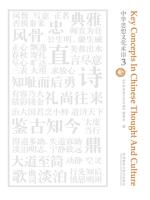。。
Unlocking the Richness of Chinese Culture: A Review of "Chinese Cultural Terms 3"
In the ever - expanding landscape of cross - cultural understanding, "Chinese Cultural Terms 3" emerges as a remarkable guide, bridging the gap between the profound Chinese cultural heritage and the global audience. This volume, a part of a significant cultural project, is a treasure trove for those eager to delve into the depths of Chinese thought, values, and traditions.
A Diverse Tapestry of Concepts
The book presents a carefully curated collection of terms that span a wide spectrum of Chinese culture. From the philosophical musings of ancient sages to the practical wisdom embedded in daily life, each term is a window into a different aspect of China's long - standing civilization. Concepts like "Ren" (仁), which embodies the Confucian ideal of benevolence, and "Dao" (道), representing the fundamental principle of the universe in Daoist thought, are not only defined but also elaborated with historical context and relevant examples. This allows readers to grasp not just the literal meaning but also the cultural and historical significance behind these terms.
Scholarly Rigor Meets Accessibility
One of the most commendable aspects of "Chinese Cultural Terms 3" is the balance it strikes between academic accuracy and readability. The explanations are the result of in - depth research by experts in the field, ensuring that the translations and interpretations are faithful to the original sources. At the same time, the language used is straightforward, making it accessible to both scholars and general readers with an interest in Chinese culture. Each term entry typically includes a Chinese character, its pinyin transcription, an English translation, a detailed explanation, and often, classical quotations that illustrate its usage in historical texts. This multi - faceted approach enriches the learning experience and enables readers to engage with the terms on multiple levels.
Catalyst for Cross - Cultural Dialogue
In an era of increasing globalization, this book serves as an invaluable tool for promoting cross - cultural dialogue. By providing accurate translations and comprehensive explanations of Chinese cultural terms, it helps non - Chinese speakers overcome the language and cultural barriers that often impede a true understanding of China. It also offers Chinese learners of English a resource to enhance their cross - cultural communication skills, enabling them to share their cultural heritage more effectively on the global stage. For example, when discussing Chinese art, terms like "Shanshui" (山水, literally "mountain - water", often used to describe a genre of Chinese landscape painting) can be better understood by international audiences through the detailed analysis in this book.
Room for Expansion and Adaptation
While "Chinese Cultural Terms 3" is an outstanding contribution, there is always room for improvement. As Chinese culture continues to evolve and interact with the world, some modern and emerging cultural concepts could be included in future editions to keep the collection relevant. Additionally, more visual aids such as images, calligraphy samples, or short cultural videos could be incorporated, either in print - on - demand versions or as digital supplements, to enhance the learning experience and make the cultural terms even more vivid.
In conclusion, "Chinese Cultural Terms 3" is an essential read for anyone interested in Chinese culture, language, or history. It not only imparts knowledge but also fosters a deeper appreciation for the complexity and beauty of Chinese civilization, making it a highly recommended addition to any cultural studies library.



 京公网安备 11010802032529号
京公网安备 11010802032529号